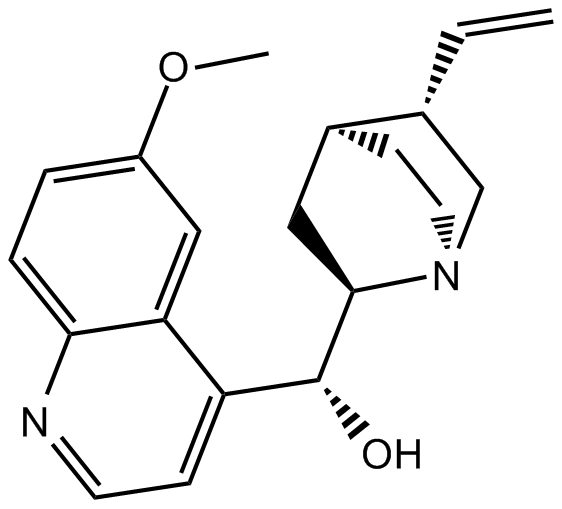Quinidine (Synonyms: (+)-Quinidine, β-Quinidine) |
| Katalog-Nr.GC14264 |
Chinidin ist ein Antiarrhythmikum.
Products are for research use only. Not for human use. We do not sell to patients.

Cas No.: 56-54-2
Sample solution is provided at 25 µL, 10mM.
Quinidine is an antiarrhythmic agent for the treatment of abnormal heart rhythms and also malaria.
Quinidine is a clinical anti-arrythmic drug which affects ionic currents in heart muscle and which has also been shown to be a potent blocker of several classes of K+ channel in a variety of cell types. Bath application of quinidine causes a dose-dependent reduction of the peak amplitude of Ik. The Kd for blockade of Ik at 0 mV is estimated to be 41 μM. Quinidine elicits a dose-dependent increase of the rate of the decay of Ik and this effect is enhanced by membrane depolarization. Quinidine also causes a 5 mV hyperpolarizing shift of the steady-state inactivation curve and increases the half-time for recovery from inactivation. Quinidine does not affect the onset of inactivation measured at -30 mV[1].
Quinidine sulfate is rapidly absorbed, with peak plasma concentrations 60-90 min after an oral dose. Other salts (gluconate, polygalacturonate) are more slowly absorbed, with lower peak concentrations. Quinidine is approximately 70-90 % bound to plasma proteins. It undergoes hepatic oxidative metabolism to form an N-oxide, a 3-hydroxy form, an O-demethyl form and 2'-quinidinone. Over one-half of patients starting quinidine stop within the first year of therapy because of side effects. These include, commonly, diarrhea, nausea, and vomiting which are not necessarily related to high plasma concentrations[2]. Quinidine inhibits metabolism of amphetamine in rats. Quinidine pretreatment results in a significant decrease in the excretion of p-hydroxyamphetamine at 24 and 48 h to 7.2 and 24.1% of the vehicle-control levels, respectively, accompanied by a significant increase in amphetamine excretion between 24 and 48 h to 542% of the control[3].
References:
[1]. Kehl SJ, et al. Quinidine-induced inhibition of the fast transient outward K+ current in rat melanotrophs. Br J Pharmacol. 1991 Jul;103(3):1807-13.
[2]. Roden DM, et al. Class I antiarrhythmic agents: quinidine, procainamide and N-acetylprocainamide, disopyramide.
[3]. Moody DE, et al. Quinidine inhibits in vivo metabolism of amphetamine in rats: impact upon correlation between GC/MS and immunoassay findings in rat urine. J Anal Toxicol. 1990 Sep-Oct;14(5):311-7.
Average Rating: 5 (Based on Reviews and 21 reference(s) in Google Scholar.)
GLPBIO products are for RESEARCH USE ONLY. Please make sure your review or question is research based.
Required fields are marked with *




















